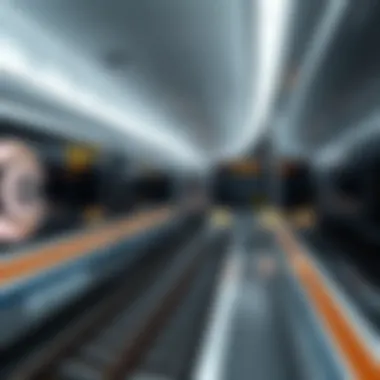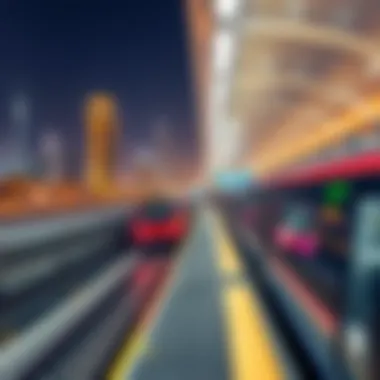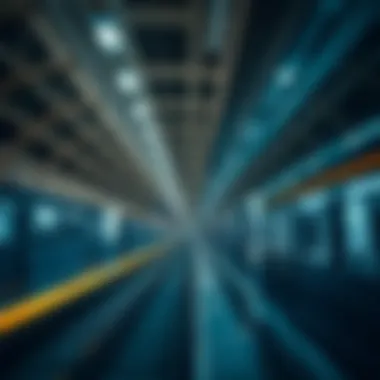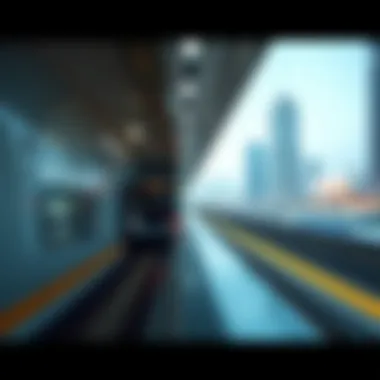Exploring the Dubai Metro: Key Insights and Impact


Intro
Dubai, the glittering gem of the United Arab Emirates, has always been known for its towering skyscrapers and luxurious lifestyle. However, underneath this grandeur lies a sophisticated transport network that plays a crucial role in connecting the bustling city. The Dubai Metro, with its sleek design and efficient operation, is at the heart of this network. It isn't just a mode of transport; it's a significant factor shaping the real estate market and urban development in this ever-evolving metropolis.
The metro system, inaugurated in 2009, has rapidly become a lifeline for both residents and visitors. Whether you are an expat looking for a place to live, an investor scouting for lucrative opportunities, or a tourist eager to explore the sights, understanding how the metro operates will enrich your experience in Dubai. The integration of the metro with various commercial hubs and leisure destinations adds immense value to the properties nestled near its stations.
Throughout this guide, we will peel back the layers of the Dubai Metro, examining not just its layout and functionalities, but also its deeper influence on the surrounding real estate landscape. We’ll dive into market trends, current analyses, and future projections, providing practical insights that could inform your decisions in this vibrant city. Prepare to navigate through essential information as we explore the Dubai Metro and its role as a backbone of urban infrastructure.
Prologue to the Dubai Metro
When one thinks about urban development, the Dubai Metro shines as a prime example of innovation in public transport. As the arteries of the city's layout, the metro system shapes not only how residents and tourists traverse the city but also influences broader elements of life in Dubai. It serves as a lifeline for expats, investors, and tourists alike, enhancing connectivity and accessibility. The benefits that stem from this network are numerous, touching on convenience, economic growth, and environmental sustainability.
Overview and Significance
The Dubai Metro stands out in a rapidly developing world, where efficient transport systems are crucial for metropolitan life. It provides a fast, reliable way to navigate the sprawling landscape of this vibrant city. Not only does the metro facilitate daily commutes, but it has also reshaped the dynamics of urban living.
Key benefits of the metro include:
- Efficiency: Avoiding the notorious traffic jams that can plague Dubai, especially during peak hours.
- Sustainability: Promoting eco-friendly travel by reducing the carbon footprint associated with personal vehicles.
- Cost-Efficiency: Offering various ticketing options that cater to both frequent users and tourists, ensuring affordability.
- Accessibility: Connecting major neighborhoods and economic centers makes it a skeleton that supports the city's growth.
Moreover, when analyzing the real estate landscape, one sees how the metro acts like a double-edged sword. Property values in areas surrounding metro stations tend to increase, making proximity to a station a desirable factor for home buyers and investors.
In essence, understanding the metro isn't just about navigating the railways. It provides insights into the socio-economic fabric of Dubai and encourages an exploration of residential and commercial opportunities that arise from this extensive network.
Historical Development
The origin of the Dubai Metro narrates an interesting story of ambition and foresight. Inaugurated in 2009, the first phase of its construction took place against a backdrop of rapid urbanization. The thought process behind establishing such a system stemmed from the city's vision to boost public transportation and alleviate traffic woes. Before the metro, the driving experience in Dubai involved numerous hurdles, ranging from congestion to high pollution rates.
From its humble beginnings with just 52 kilometers of track, it has since expanded, reflecting a commitment made by the Dubai government toward modernization.
As the years have rolled by, the metro network emphasized the need for expansion, leading to the addition of the Green Line and future lines like the Purple Line on the horizon. These developments aren't just transportation projects; rather, they represent a vital component of urban planning, bringing together economic growth and improved living conditions.
In summary, the Dubai Metro is a testament to the city's capacity to evolve and adapt. Its historical roots reflect an understanding of the importance of public transport in urban landscapes—making it a central player in shaping Dubai's future.
Metro Map Analysis
The map of the Dubai Metro is not simply a representation of lines and stations; it's a crucial tool for anyone looking to traverse this vibrant city efficiently. Its layout informs users of their options, helps in planning travel routes, and ultimately enhances the overall commuting experience. Understanding this imagery can make navigating the sprawling metropolis feel less like a daunting task and more like a walk in the park.
Understanding the Layout
A clear grasp of the metro layout is essential for both first-time visitors and seasoned commuters. The entire system is designed with logic and user-friendliness in mind. Each line is color-coded, making it simple to differentiate between them at a glance. Lines branch out and intersect at various points, which serves to streamline connections and minimize travel time. Stations are strategically placed in high-traffic areas, ensuring access to shopping centers, business districts, and residential neighborhoods. This planning is not random; it reflects the significant investment in infrastructure tailored to meet the needs of a growing population.


Metro Lines Overview
The importance of the metro lines cannot be overstated; they form the very backbone of Dubai's public transport system. Each line serves a specific purpose and caters to different areas, making the metro not only a convenient choice but often the quickest way to get around the city.
Red Line
The Red Line is a standout feature of the Dubai Metro. Running essentially in a straight line from Rashidiya to UAE Exchange, it covers many key areas including Dubai Mall, the economic hub of the city. Its popularity hinges on several factors: frequent service, accessibility to popular destinations, and even its air-conditioned environment, which can make a world of difference in the sweltering summer heat. The unique characteristic of the Red Line is its elevated train system, offering passengers stunning views of the city skyline. Overall, the Red Line is highly beneficial for both tourists and locals alike, propelling its status as the lifeblood of public transportation in Dubai.
Green Line
In contrast, the Green Line serves as an important complement to the Red Line, stretching from Etisalat to Dubai Creek. Its analysis reveals a balance between areas rich in cultural significance and bustling commercial zones. Highlighting its unique feature, this line runs through many localities that showcase the more traditional side of Dubai, such as Al Fahidi. Regular commuters favor the Green Line for its easy access to shopping and cultural sites, making it an excellent choice for anyone looking to delve deeper into the city’s heritage. However, it does have limitations in terms of the number of stations compared to the Red Line, which could require transfers to fully explore certain destinations.
Future Extensions
The future extensions planned for the Dubai Metro signal a forward-thinking approach to urban growth. Expansions are set to connect more districts, including developments in Dubai South, and may even extend towards neighboring emirates. The key characteristic of these future additions is their potential to improve connectivity for both residents and visitors, thereby encouraging further economic hotspots. What's more, the anticipated integration of smart technology into these extensions could revolutionize the commuting experience, making it smoother and more efficient. However, the scalability of construction projects adds a layer of complexity and could lead to temporary inconveniences during the development phases.
The Metro Map Analysis not only illustrates current infrastructures but also hints at a future that aims to enhance transport efficiency across Dubai. As the city continues to innovate, understanding its public transport system becomes essential—for residents, expats, and investors alike.
"The metro is more than a mode of transport in Dubai; it's a vibrant vein through which the lifeblood of the city flows."
For further information about the metro system and its operational details, visit the official RTA Dubai website.
Major Stations and Their Impact
The Dubai Metro serves as a backbone for the city’s public transportation, interconnecting various regions and dramatically influencing urban growth. Each major station not only facilitates commuter movement but also catalyzes commercial and residential development nearby. Understanding the critical role these stations play is paramount for investors, expats, agents, buyers, and renters seeking optimal locations in this vibrant metropolis.
Key Interchange Stations
Interchange stations are the lifeblood of the metro system, making travel seamless between the different lines. For instance, the Burjuman station connects the Red Line and Green Line, acting like a hub that mitigates travel time across the city. Another pivotal station is Union, which serves as a junction between the two main lines, enhancing accessibility for passengers.
These stations are designed with user convenience in mind. They typically feature ample signage, provide easy stair and escalator access, and are equipped with ticket counters. Moreover, the shopping facilities within these interchange hubs cater to both residents and travelers, offering a mix of retail and dining options.
The proximity of key interchange stations to major tourist spots underscores their importance. For instance, the Union station is situated not far from attractions like the Dubai Museum and Al Fahidi Historical Neighborhood, linking culture with convenience.
Stations and Nearby Attractions
The effectiveness of the Dubai Metro is not merely in the stations themselves but in their strategic locations. Many stations are situated within walking distance of notable attractions, becoming a cornerstone for tourists and locals alike.
- Burj Khalifa/Dubai Mall Station: This station is a stone's throw from the world’s tallest building and the sprawling Dubai Mall, offering not just shopping but cultural experiences and entertainment.
- Mall of the Emirates Station: Here, riders can access the iconic Mall of the Emirates, where the indoor ski slope beckons both thrill-seekers and shopaholics.
- Jumeirah Lake Towers Station: Nestled by glistening lakes and scenic views, this station is a gateway to desirable residential communities and the lively JLT Park.
Residential Developments Near Stations
The landscape surrounding major metro stations has turned into a hotbed for residential development. Properties situated close to metro stations often come at a premium, but the investment potential is undeniable. Notably, living near a metro station can save residents considerable time on their daily commute—an appealing factor for many.


- Dubai Marina: The station here has led to a surge in skyscraper apartments that boast waterfront views, attracting expats from around the globe.
- Downtown Dubai: With the Burj Khalifa station, this area has seen a flourishing of luxury residences, perfect for individuals seeking both opulence and accessibility.
- Business Bay: Proximity to the metro enhances the desirability of residential options in this area, particularly for young professionals working in the nearby financial district.
In summary, the impact of major metro stations extends beyond transportation. They create thriving ecosystems surrounding them, influencing urban development, real estate value, and the overall livability of the city. Understanding these dynamics is crucial for anyone looking to navigate the intricacies of life and investment in Dubai.
User Experience and Practicalities
When it comes to navigating the Dubai Metro, the user experience is paramount. The metro is not merely a transportation system; it’s an integral part of daily life for residents and visitors. It offers convenience, cost-effectiveness, and connectivity that transforms how people move around this sprawling city. By understanding the practical aspects of using the metro, one can navigate the system with ease and leverage its benefits fully.
Ticketing and Pricing Structure
Navigating any transit system begins with understanding how to pay for services. The Dubai Metro employs a straightforward ticketing system that caters to varying needs of its users. Tickets can be purchased at kiosks and vending machines located at every station, ensuring that no one is left stranded.
- NOL Cards: For frequent riders, investing in a NOL card proves worthwhile. This reloadable card not only allows for seamless travel across the metro but also is valid for other public transport modes throughout the city.
- Cost Factors: Pricing is tiered based on distance traveled. The metro smartly divides Dubai into zones, making it easier for riders to gauge costs.
- Discounts: There are discounts available for students, senior citizens, and people with disabilities. Understanding these nuances can lead to significant savings.
"The right ticket can change your journey from simple to seamless."
Operating Hours and Frequency
Another vital aspect of the user experience lies in the operating hours and frequency of service. The Dubai Metro runs consistently, making it a reliable choice for commuters.
- Operating Times: The metro typically operates from 5:00 AM to midnight on weekdays, with extended hours on weekends. This flexibility enables riders to plan their travels according to their schedules without hassle.
- Train Frequency: During peak hours, trains arrive every few minutes—ideal for those rushing to work. Outside these hours, wait times are still reasonable, usually not exceeding ten minutes.
This regularity in service gives peace of mind to users, permitting them to make plans without being overly concerned about long waits.
Accessibility Features
Inclusivity is an essential feature of the Dubai Metro. Efforts have been made to ensure that every individual, regardless of ability, can comfortably use the metro system.
- Designated Areas: Each station possesses designated areas for the differently-abled, complete with slope access for easy boarding and alighting.
- Visual and Auditory Assistance: Trains and stations are equipped with visual displays and auditory announcements, creating an accommodating environment for all visitors.
- Staff Assistance: Metro staff are trained to assist those needing help, ensuring that everyone can navigate the metro with confidence and ease.
In summary, a well-thought-out user experience is at the core of the Dubai Metro. Its efficient ticketing system, operational reliability, and emphasis on accessibility combine to create a commuting experience that minimizes stress and maximizes convenience. This understanding is particularly vital for investors and expats, as a smoother commuting experience translates to better choices in residential and commercial placements.
Metro's Role in Real Estate Dynamics
The presence of a structured metro system is more than just a convenient transport option; it dramatically reshapes real estate dynamics in a bustling city like Dubai. The Dubai Metro, with its extensive network, plays a pivotal role in influencing property values, attracting investments, and guiding urban development in a way that many might not immediately grasp. The synergy between public transport and real estate not only enhances the livability of areas but also opens up avenues for substantial returns on investment.
Impact on Property Values
The relationship between the Dubai Metro and property values can be likened to better fuel efficiency in a car—more accessibility often translates to higher desirability. When properties are situated near metro stations, they typically see a surge in their market value. The properties’ proximity to transit options reduces commute times and increases accessibility to key areas, which makes them highly attractive to renters and buyers alike.
Research shows that properties within a radius of 500 meters from metro stations often witness appreciation rates significantly above the city average. This trend is particularly noticeable in neighborhoods like Dubai Marina and Downtown Dubai, where luxury condos and residences can be found. Key influences include ease of access to the business districts, iconic attractions, and leisure areas, not to mention the reduction in travel costs associated with owning a vehicle.
"In urban areas, proximity to public transport is one of the leading indicators of property value."


Investment Opportunities Near Metro Stations
Investing near a metro line is often viewed as a surefire way to bet on growth. Investors tend to flock to areas with new metro stations being planned or developed, anticipating that the investment landscape will shift in their favor. For instance, properties along the Red Line have seen an uptick in rental prices. With ongoing expansions and new lines being introduced, such as the proposed Route 2020 extension, savvy investors have a unique opportunity to acquire underpriced real estate that is poised for appreciation.
The adaptability and forward thought associated with the metro system often invite commercial developments near stations as well. Cafés, retail shops, and office spaces all chime in on the business potential of being accessible by metro. These commercial opportunities enhance the local economic landscape and present investors the chance to diversify their portfolios with both residential and commercial assets.
Trends in Neighborhood Development
With the metro’s arrival, we see neighborhoods transforming at astonishing rates. Urban planners are increasingly incorporating transit-oriented development (TOD) strategies, which encourage higher-density mixed-use development around metro stations. This approach not only fosters community but also promotes sustainability through reduced reliance on cars. As developers recognize the benefits of building near these transit hubs, we witness a more vibrant urban fabric develop within the spheres of influence of metro stations.
Areas once deemed too peripheral can emerge as hotspots for living and working. Communities like Al Quoz and Jumeirah Village Circle are examples where significant developments have surfaced due to their strategic positioning near the metro. While existing spaces are revitalized, new residential complexes rise, featuring modern amenities, parks, and communal spaces, thus contributing to the overall quality of life for residents.
Investments made in these areas can yield solid capital appreciation as more people choose convenience over long commutes.
Future of the Dubai Metro
The Dubai Metro stands as a testament to modern urban design and planning, continually adapting to the city’s evolving needs. As a linchpin of Dubai's public transport system, its future holds great significance not just for daily commuters, but for the broader economic landscape as well. Here, we’ll delve into the vision guiding the expansion and technological upgrades that are smoothing the path ahead.
Expansion Plans
Expansion is at the heart of the future for the Dubai Metro. Anticipating increasing demand, the Roads and Transport Authority (RTA) has laid out ambitious plans to extend existing lines and introduce new ones. These extensions are more than just lines on a map; they symbolize accessibility and economic opportunity.
- New Lines: There are upcoming developments for both the Red and Green Lines, which aim to connect unearthed districts and crucial economic hubs, such as the Dubai World Central. Expanding the reach ensures that more parts of the city are easily accessible, thus supporting enhanced property values and improving daily convenience.
- Integration with Other Modes of Transport: There's also a focus on unifying the metro with bus and water transport systems. Seamless transfers will not only make commutes smoother but also enhance the overall transportation network.
"The metro’s expansion reflects Dubai's commitment to infrastructural growth and sustainability, making it a key driver for future urban development."
This strategic expansion efforts encourage developers and investors to eye properties near proposed stations. Properties in these areas are likely to see a rise in value, compelling investors to position themselves ahead of the curve.
Technological Innovations
In our increasingly digital world, technological innovations are critical to maintaining the efficiency and allure of any public transport system. The Dubai Metro is proactively embracing cutting-edge technology to improve user experience and operational efficiency.
- Smart Ticketing Solutions: The introduction of smart ticketing systems powered by cutting-edge app technology simplifies the ticket purchasing process. This includes user-friendly mobile applications that allow passengers to purchase tickets remotely, track train schedules, and even plan their routes with precision.
- Advanced Safety Systems: Safety remains paramount. Innovations in subway safety technology, such as advanced signaling systems and real-time monitoring, are being introduced. These systems enhance the reliability of the metro service, ensuring the safety of all passengers at any given time.
- Sustainability Initiatives: The metro is also taking strides toward becoming more environmentally friendly. Plans include incorporating solar panels and energy-efficient practices, aligning with Dubai's long-term goal of sustainability. This commitment not only reduces the carbon footprint but also enhances Dubai's image as a forward-thinking metropolis.
As these technological advancements unfold, the metro system will not only cater to current demand but also set a robust foundation for future growth. It's clear that the future of the Dubai Metro, filled with expansion and innovation, is a vital piece of the city’s urban puzzle, promising to further enhance its status as a global hub for business and tourism.
Epilogue
The conclusion serves as a vital final touchpoint for readers looking to consolidate their understanding of the Dubai Metro. It encapsulates the amalgamation of insights presented throughout the article, highlighting key themes like connectivity, urban development, and user experience. As the metro continues to grow and adapt, its significance in the fabric of Dubai's urban landscape cannot be overstated.
Summary of Key Insights
To wrap things up, here’s a summary of the essential insights gathered:
- Connecting Communities: The Dubai Metro plays a critical role in linking various neighborhoods and commercial hubs, making it easier for individuals to navigate the sprawling city.
- Impact on Real Estate: Proximity to metro stations positively affects property values, drawing investors and residents who prioritize accessibility and convenience.
- Future Prospects: With planned expansions and technological advancements, the metro is set to shape Dubai’s growth trajectory for years to come.
- User-Centric Design: From ticketing to accessibility features, the design of the Metro caters to a diverse user base, enhancing the overall travel experience.
"Urban spaces evolve, and the Dubai Metro is a testament to how transport infrastructure can drive change in a city."
Understanding the dynamics of the Dubai Metro is essential for investors, expats, agents, and renters aiming to optimize their experience within this remarkable city. By dissecting the network's layers—its lines, stations, and the neighborhoods they influence—readers can make informed decisions that align with their lifestyle and investment goals.



